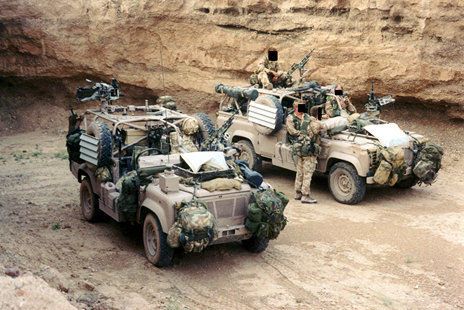Late summer, with its sunny weather, provided a pleasant backdrop for the 20th annual inspection/reception of the Kommando Spezialkräfte (KSK), one of Germany’s most elite special operations units. The event was held at the illustrious Ludwigsburg Palace near Stuttgart City on September 13, 2016. Seven hundred soldiers belonging to the unit were present. There was also a large cast of political and military figures from home and abroad in attendance.
In his speech, Brigade General Dag Baehr, commander of the SF unit, hailed the last 20 years as a “success story” and praised the professionalism of his soldiers. He also stressed that the soldiers more than surpassed the level of professionalism expected from them.
U.S. envoy Kent Logsdon took this opportunity to present a unit citation for the unit’s support of U.S. forces in Afghanistan between October, 2001 and March, 2002. During the years of the Afghanistan mission, no opportunity up to this point had been available to present the unit with the honor in an appropriate manner. Prior to this, on the 7th of December, 2004, President Bush offered the members of the unit the Presidential Unit Citation for their exceptional courage and esprit de corps during the execution of their mission under extremely arduous and difficult circumstances.
History of the KSK
The KSK was officially initiated on the orders of then-Defense Minister Volker Rühe on the 20th of September, 1996. His statement regarding the unit’s development was as follows: “The capability to rescue national citizens abroad in case of emergency is a basic necessity and responsibility of every state.”
This was the nation’s reaction to a newly identified security shortcoming: the lack of the capability to evacuate German nationals taken hostage abroad. Until then, the German government was compelled to ask repeatedly for foreign SF units to offer assistance in times of crisis. Such was the painful case in the ’90s involving the rescue and subsequent evacuation of German citizens by Belgian para-commandos in Kigali, Rwanda. Even though the GSG 9 border police were initiated during the ’70s, they were not adequately trained or kitted out to operate effectively in a military worst-case scenario.
The unit was founded with the manpower from the disbanded units of the airborne brigade 25 and the Long Range Reconnaissance Unit 100/300. Even though many garrison locations were in contest with one another to offer the new unit a home, the KSK eventually found their home in Calw, in the county of Baden-Wuertemberg. With a lot of enthusiasm, the leaders took it upon themselves to oversee and mentor the project, using the philosophy, “What are we capable of? What can others do better?” In a close working relationship with the GSG9, the respected and experienced British SAS, and various other special operations units from the U.S., many solid training and mission concepts were initiated and new structural guidelines were established. In April, 1997, the first platoon of the KSK reported operational readiness. In the following 14-day exercise “Rapid Eagle,” the soldiers demonstrated their operational status by successfully carrying out an evacuation. From 1998 on, the KSK participated on all out-of-area missions. The well known mission locations have been and are still—Bosnia, Kosovo, and from 2001 on, Afghanistan.
Simultaneously, elements are also posted in the Middle East and in North Africa on training missions. The main focus here is on the mentorship of regional SF schools, with the intent that these units are able to carry out effective military field operations as well as in partnership with other units. Concerning the September 11, 2001 attack in New York, the global security threat was updated and lead to a new analysis and subsequent military capabilities worldwide. The Western world entered into the War on Terror. Consequently the new mission spectrum of the commandos involved the gaining of information as well as the identifying and subsequent arrest of the insurgent leadership.
The missions were increased and this showed the unit their own limits regarding manpower and logistical support. Currently, the unit has introduced 15 highly agile support helicopters,the H145M LUHSOF from Airbus Helicopter. Also, new Mobile platforms have been introduced for tactical applications. The Special Operation Vehicle (SOV) manufactured by Krauss-Maffei Wegmannis Air transportable, on a modular chassis. This particular model is destined for SF use since it combines great mobility with great operational range. The KSK’s equipment is being updated at all times since their conception. In many ways the whole unit is a pool for the trialing of new mission-orientated gear, and if proven, such equipment will certainly find its way to other army units on the whole.
On the Day of the Bundeswehr on 11th June 2016, held on the Air force Base Hohn in Schleswig-Holstein and on the maneuver area Munster (lower Saxony) one could observe the demanding work of the Modern Soldiers on duty. During these highly professional demonstrations the Commando Troopers displayed their complex abilities concerning atypical Hostage situation. The opportunity for local residents to inform themselves in this way was taken up by 20,000 visitors in Hohn alone. The German public’s interest in its own soldiers has vastly increased in the recent years.
Featured image courtesy of eliteukforces.info










COMMENTS
You must become a subscriber or login to view or post comments on this article.